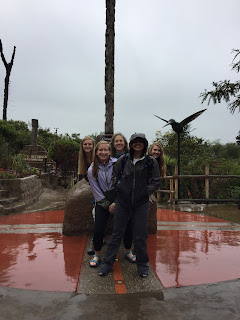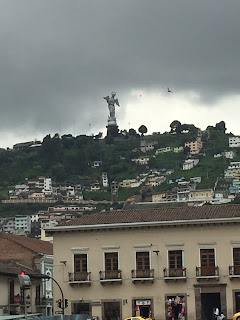At around 10:40am we arrived in a town called Otavalo, where there are 43,000 people who are mostly indigenous. Most things in this town are managed and owned by the indigenous rather than the mestizos. The weather was very rainy while we were there, and we noticed Otavaleños wear plastic bags over their hats when it rains, because they are so expensive. In other communities, people did not do the same thing.
While in Otavalo, we went to the Plaza de los Ponchos where there was a very large indigenous market going on. This was a poor decision, as I splurged on most things that were offered to me. It was perfect though, because everything was being sold there!
After Otavalo, we then arrived in a town called Peguche, known for its weaving. The women of this area have their hair in braids that are wrapped. We went to a beautiful shop that sold apparel, made of llama, alpaca, and sheep wool! It was exciting to feel all the different textures and even see how the weaving is done.
We then went to a restaurant called Palmeras de Quichinche around 1:15, which was delicious! And we even had the exciting opportunity to see a few llamas in the front, as well as a large vegetable garden and some cute pet guinea pigs in the back! The owner assured us they were kept as pets, not as future meals.
Thinking lunch would be our last stop, we arrived at Cui Cocha (Guinea Pig Lake) which was absolutely stunning! It is well known for being a volcanic lake with a beautiful view.
Lastly, we drove through a town called Cotacachi, which besides Cuenca, is another area where couples from North America and the UK like to retire. It was a very cute town with many shops that were inclusive to english speakers!
We arrived at the airport around 6:30, said our goodbyes to Gloria, our wonderful tour guide, and Gino, our amazing driver, both of whom we got to know over the past few days! Once we entered, we had some dinner and there were some flight troubles, but all in all everything is great, and this experience was life changing!












































